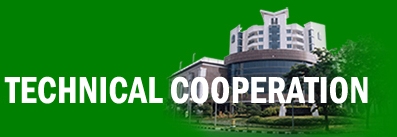|
Computer
Evolution
Computer History and Development
Nothing
epitomizes
modern life better than the computer. For better or worse, computers
have infiltrated every aspect of our society. Today computers do much
more than simply compute: supermarket scanners calculate our grocery
bill while keeping store inventory; computerized telephone switching
centers play traffic cop to millions of calls and keep lines of
communication untangled; and automatic teller machines (ATM) let us
conduct banking transactions from virtually anywhere in the world. But
where did all this technology come from and where is it heading? To
fully understand and appreciate the impact computers have on our lives
and promises they hold for the future, it is important to understand
their evolution.
Early Computing Machines and Inventors
The
abacus, which emerged about 5,000 years ago in Asia Minor and is still
in use today, may be considered the first computer. This device allows
users to make computations using a system of sliding beads arranged on a
rack. Early merchants used the abacus to keep trading transactions. But
as the use of paper and pencil spread, particularly in Europe, the
abacus lost its importance. It took nearly 12 centuries, however, for
the next significant advance in computing devices to emerge. In 1642,
Blaise Pascal (1623-1662), the 18-year-old son of a French tax
collector, invented what he called a numerical wheel calculator to help
his father with his duties. This brass rectangular box, also called a
Pascaline, used eight movable dials to add sums up to eight figures
long. Pascal's device used a base of ten to accomplish this. For
example, as one dial moved ten notches, or one complete revolution, it
moved the next dial - which represented the ten's column - one place.
When the ten's dial moved one revolution, the dial representing the
hundred's place moved one notch and so on. The drawback to the Pascaline,
of course, was its limitation to addition.
|
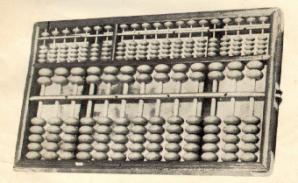
Figure
2. Abacus
Device
|
|

Figure
2.
Pascaline
|
In
1694, a German mathematician and philosopher, Gottfried Wilhem von
Leibniz (1646-1716), improved the Pascaline by creating a machine that
could also multiply. Like its predecessor, Leibniz's mechanical
multiplier worked by a system of gears and dials. Partly by studying
Pascal's original notes and drawings, Leibniz was able to refine his
machine. The centerpiece of the machine was its stepped-drum gear
design, which offered an elongated version of the simple flat gear. It
wasn't until 1820, however, that mechanical calculators gained
widespread use. Charles Xavier Thomas de Colmar, a Frenchman, invented a
machine that could perform the four basic arithmetic functions. Colmar's
mechanical calculator, the arithometer, presented a more practical
approach to computing because it could add, subtract, multiply and
divide. With its enhanced versatility, the arithometer was widely used
up until the First World War. Although later inventors refined Colmar's
calculator, together with fellow inventors Pascal and Leibniz, he helped
define the age of mechanical computation.
|
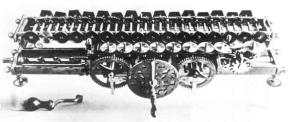
Figure
3. Leibniz
Machine
|
The real beginnings of
computers as we know them today, however, lay with an English
mathematics professor, Charles Babbage (1791-1871). Frustrated at the
many errors he found while examining calculations for the Royal
Astronomical Society, Babbage declared, "I wish to God these
calculations had been performed by steam!" With those words, the
automation of computers had begun. By 1812, Babbage noticed a natural
harmony between machines and mathematics: machines were best at
performing tasks repeatedly without mistake; while mathematics,
particularly the production of mathematics tables, often required the
simple repetition of steps. The problem centered on applying the ability
of machines to the needs of mathematics. Babbage's first attempt at
solving this problem was in 1822 when he proposed a machine to perform
differential equations, called a Difference Engine. Powered by steam and
large as a locomotive, the machine would have a stored program and could
perform calculations and print the results automatically. After working
on the Difference Engine for 10 years, Babbage was suddenly inspired to
begin work on the first general-purpose computer, which he called the
Analytical Engine. Babbage's assistant, Augusta Ada King, Countess of
Lovelace (1815-1842) and daughter of English poet Lord Byron, was
instrumental in the machine's design. One of the few people who
understood the Engine's design as well as Babbage, she helped revise
plans, secure funding from the British government, and communicate the
specifics of the Analytical Engine to the public. Also, Lady Lovelace's
fine understanding of the machine allowed her to create the instruction
routines to be fed into the computer, making her the first female
computer programmer. In the 1980's, the U.S. Defense Department named a
programming language ADA in her honor.
|
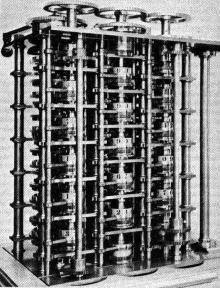
Figure
4. Babbage
Machine
|
Babbage's
steam-powered Engine, although ultimately never constructed, may seem
primitive by today's standards. However, it outlined the basic elements
of a modern general purpose computer and was a breakthrough concept.
Consisting of over 50,000 components, the basic design of the Analytical
Engine included input devices in the form of perforated cards containing
operating instructions and a "store" for memory of 1,000
numbers of up to 50 decimal digits long. It also contained a
"mill" with a control unit that allowed processing
instructions in any sequence, and output devices to produce printed
results. Babbage borrowed the idea of punch cards to encode the
machine's instructions from the Jacquard loom. The loom, produced in
1820 and named after its inventor, Joseph-Marie Jacquard, used punched
boards that controlled the patterns to be woven.
|
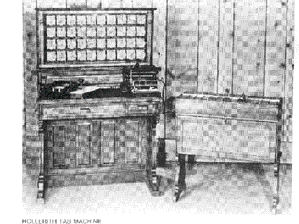
Figure
5. Hollerith
Machine
|
In
1889, an American inventor, Herman Hollerith (1860-1929), also applied
the Jacquard loom concept to computing. His first task was to find a
faster way to compute the U.S. census. The previous census in 1880 had
taken nearly seven years to count and with an expanding population, the
bureau feared it would take 10 years to count the latest census. Unlike
Babbage's idea of using perforated cards to instruct the machine,
Hollerith's method used cards to store data information which he fed
into a machine that compiled the results mechanically. Each punch on a
card represented one number, and combinations of two punches represented
one letter. As many as 80 variables could be stored on a single card.
Instead of ten years, census takers compiled their results in just six
weeks with Hollerith's machine. In addition to their speed, the punch
cards served as a storage method for data and they helped reduce
computational errors. Hollerith brought his punch card reader into the
business world, founding Tabulating Machine Company in 1896, later to
become International Business Machines (IBM) in 1924 after a series of
mergers. Other companies such as Remington Rand and Burroghs also
manufactured punch readers for business use. Both business and
government used punch cards for data processing until the 1960's.
In
the ensuing years, several engineers made other significant advances.
Vannevar Bush (1890-1974) developed a calculator for solving
differential equations in 1931. The machine could solve complex
differential equations that had long left scientists and mathematicians
baffled. The machine was cumbersome because hundreds of gears and shafts
were required to represent numbers and their various relationships to
each other. To eliminate this bulkiness, John V. Atanasoff (b. 1903), a
professor at Iowa State College (now called Iowa State University) and
his graduate student, Clifford Berry, envisioned an all-electronic
computer that applied Boolean algebra to computer circuitry. This
approach was based on the mid-19th century work of George Boole
(1815-1864) who clarified the binary system of algebra, which stated
that any mathematical equations could be stated simply as either true or
false. By extending this concept to electronic circuits in the form of
on or off, Atanasoff and Berry had developed the first all-electronic
computer by 1940. Their project, however, lost its funding and their
work was overshadowed by similar developments by other scientists.
Five Generations of Modern Computers
First Generation (1945-1956)
With
the onset of the Second World War, governments sought to develop
computers to exploit their potential strategic importance. This
increased funding for computer development projects hastened technical
progress. By 1941 German engineer Konrad Zuse had developed a computer,
the Z3, to design airplanes and missiles. The Allied forces, however,
made greater strides in developing powerful computers. In 1943, the
British completed a secret code-breaking computer called Colossus to
decode German messages. The Colossus's impact on the development of the
computer industry was rather limited for two important reasons. First,
Colossus was not a general-purpose computer; it was only designed to
decode secret messages. Second, the existence of the machine was kept
secret until decades after the war.
American
efforts produced a broader achievement. Howard H. Aiken (1900-1973), a
Harvard engineer working with IBM, succeeded in producing an
all-electronic calculator by 1944. The purpose of the computer was to
create ballistic charts for the U.S. Navy.
|
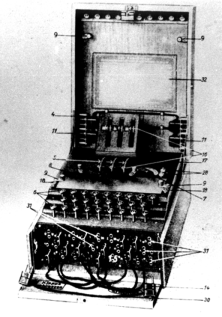
Figure
6. Colossus
Machine
|
It
was about half as long as a football field and contained about 500 miles
of wiring. The Harvard-IBM Automatic Sequence Controlled Calculator, or
Mark I for short, was an electronic relay computer. It used
electromagnetic signals to move mechanical parts. The machine was slow
(taking 3-5 seconds per calculation) and inflexible (in that sequences
of calculations could not change); but it could perform basic arithmetic
as well as more complex equations.
Another
computer development spurred by the war was the Electronic Numerical
Integrator and Computer (ENIAC), produced by a partnership between the
U.S. government and the University of Pennsylvania. Consisting of 18,000
vacuum tubes, 70,000 resistors and 5 million soldered joints, the
computer was such a massive piece of machinery that it consumed 160
kilowatts of electrical power, enough energy to dim the lights in an
entire section of Philadelphia. Developed by John Presper Eckert
(1919-1995) and John W. Mauchly (1907-1980), ENIAC, unlike the Colossus
and Mark I, was a general-purpose computer that computed at speeds 1,000
times faster than Mark I.
|
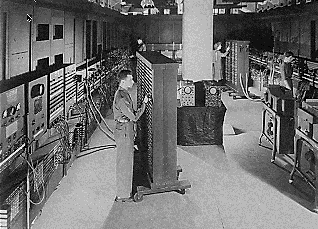
Figure
7. ENIAC
Computer
|
|
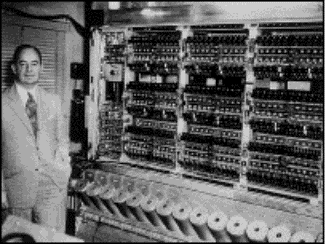
Figure
8. EDVAC
Computer
|
In
the mid-1940's John von Neumann (1903-1957) joined the University of
Pennsylvania team, initiating concepts in computer design that remained
central to computer engineering for the next 40 years. Von Neumann
designed the Electronic Discrete Variable Automatic Computer (EDVAC) in
1945 with a memory to hold both a stored program as well as data. This
"stored memory" technique as well as the "conditional
control transfer," that allowed the computer to be stopped at any
point and then resumed, allowed for greater versatility in computer
programming. The key element to the von Neumann architecture was the
central processing unit, which allowed all computer functions to be
coordinated through a single source. In 1951, the UNIVAC I (Universal
Automatic Computer), built by Remington Rand, became one of the first
commercially available computers to take advantage of these advances.
Both the U.S. Census Bureau and General Electric owned UNIVACs. One of
UNIVAC's impressive early achievements was predicting the winner of the
1952 presidential election, Dwight D. Eisenhower.
First
generation computers were characterized by the fact that operating
instructions were made-to-order for the specific task for which the
computer was to be used. Each computer had a different binary-coded
program called a machine language that told it how to operate. This made
the computer difficult to program and limited its versatility and speed.
Other distinctive features of first generation computers were the use of
vacuum tubes (responsible for their breathtaking size) and magnetic
drums for data storage.
Second Generation Computers (1956-1963)
By
1948, the invention of the transistor greatly changed the computer's
development. The transistor replaced the large, cumbersome vacuum tube
in televisions, radios and computers. As a result, the size of
electronic machinery has been shrinking ever since. The transistor was
at work in the computer by 1956. Coupled with early advances in
magnetic-core memory, transistors led to second generation computers
that were smaller, faster, more reliable and more energy-efficient than
their predecessors. The first large-scale machines to take advantage of
this transistor technology were early supercomputers, Stretch by IBM and
LARC by Sperry-Rand. These computers, both developed for atomic energy
laboratories, could handle an enormous amount of data, a capability much
in demand by atomic scientists. The machines were costly, however, and
tended to be too powerful for the business sector's computing needs,
thereby limiting their attractiveness. Only two LARCs were ever
installed: one in the Lawrence Radiation Labs in Livermore, California,
for which the computer was named (Livermore Atomic Research Computer)
and the other at the U.S. Navy Research and Development Center in
Washington, D.C. Second generation computers replaced machine language
with assembly language, allowing abbreviated programming codes to
replace long, difficult binary codes.
Throughout
the early 1960's, there were a number of commercially successful second
generation computers used in business, universities, and government from
companies such as Burroughs, Control Data, Honeywell, IBM, Sperry-Rand,
and others. These second generation computers were also of solid state
design, and contained transistors in place of vacuum tubes. They also
contained all the components we associate with the modern day computer:
printers, tape storage, disk storage, memory, operating systems, and
stored programs. One important example was the IBM 1401, which was
universally accepted throughout industry, and is considered by many to
be the Model T of the computer industry. By 1965, most large business
routinely processed financial information using second generation
computers.
It
was the stored program and programming language that gave computers the
flexibility to finally be cost effective and productive for business
use. The stored program concept meant that instructions to run a
computer for a specific function (known as a program) were held inside
the computer's memory, and could quickly be replaced by a different set
of instructions for a different function. A computer could print
customer invoices and minutes later design products or calculate
paychecks. More sophisticated high-level languages such as COBOL (Common
Business-Oriented Language) and FORTRAN (Formula Translator) came into
common use during this time, and have expanded to the current day. These
languages replaced cryptic binary machine code with words, sentences,
and mathematical formulas, making it much easier to program a computer.
New types of careers (programmer, analyst, and computer systems expert)
and the entire software industry began with second generation computers.
Third Generation Computers (1964-1971)
Though
transistors were clearly an improvement over the vacuum tube, they still
generated a great deal of heat, which damaged the computer's sensitive
internal parts. The quartz rock eliminated this problem. Jack Kilby, an
engineer with Texas Instruments, developed the integrated circuit (IC)
in 1958. The IC combined three electronic components onto a small
silicon disc, which was made from quartz. Scientists later managed to
fit even more components on a single chip, called a semiconductor. As a
result, computers became ever smaller as more components were squeezed
onto the chip. Another third-generation development included the use of
an operating system that allowed machines to run many different programs
at once with a central program that monitored and coordinated the
computer's memory.
Fourth Generation (1971-Present)
After
the integrated circuits, the only place to go was down - in size, that
is. Large scale integration (LSI) could fit hundreds of components onto
one chip. By the 1980's, very large scale integration (VLSI) squeezed
hundreds of thousands of components onto a chip. Ultra-large scale
integration (ULSI) increased that number into the millions. The ability
to fit so much onto an area about half the size of a U.S. dime helped
diminish the size and price of computers. It also increased their power,
efficiency and reliability. The Intel 4004 chip, developed in 1971, took
the integrated circuit one step further by locating all the components
of a computer (central processing unit, memory, and input and output
controls) on a minuscule chip. Whereas previously the integrated circuit
had had to be manufactured to fit a special purpose, now one
microprocessor could be manufactured and then programmed to meet any
number of demands. Soon everyday household items such as microwave
ovens, television sets and automobiles with electronic fuel injection
incorporated microprocessors.
Such
condensed power allowed everyday people to harness a computer's power.
They were no longer developed exclusively for large business or
government contracts. By the mid-1970's, computer manufacturers sought
to bring computers to general consumers. These minicomputers came
complete with user-friendly software packages that offered even
non-technical users an array of applications, most popularly word
processing and spreadsheet programs. Pioneers in this field were
Commodore, Radio Shack and Apple Computers. In the early 1980's, arcade
video games such as Pac Man and home video game systems such as the
Atari 2600 ignited consumer interest for more sophisticated,
programmable home computers.
In
1981, IBM introduced its personal computer (PC) for use in the home,
office and schools. The 1980's saw an expansion in computer use in all
three arenas as clones of the IBM PC made the personal computer even
more affordable. The number of personal computers in use more than
doubled from 2 million in 1981 to 5.5 million in 1982. Ten years later,
65 million PCs were being used. Computers continued their trend toward a
smaller size, working their way down from desktop to laptop computers
(which could fit inside a briefcase) to palmtop (able to fit inside a
breast pocket). In direct competition with IBM's PC was Apple's
Macintosh line, introduced in 1984. Notable for its user-friendly
design, the Macintosh offered an operating system that allowed users to
move screen icons instead of typing instructions. Users controlled the
screen cursor using a mouse, a device that mimicked the movement of
one's hand on the computer screen.
As
computers became more widespread in the workplace, new ways to harness
their potential developed. As smaller computers became more powerful,
they could be linked together, or networked, to share memory space,
software, information and communicate with each other. As opposed to a
mainframe computer, which was one powerful computer that shared time
with many terminals for many applications, networked computers allowed
individual computers to form electronic co-ops. Using either direct
wiring, called a Local Area Network (LAN), or telephone lines, these
networks could reach enormous proportions. A global web of computer
circuitry, the Internet, for example, links computers worldwide into a
single network of information. During the 1992 U.S. presidential
election, vice-presidential candidate Al Gore promised to make the
development of this so-called "information superhighway" an
administrative priority. Though the possibilities envisioned by Gore and
others for such a large network are often years (if not decades) away
from realization, the most popular use today for computer networks such
as the Internet is electronic mail, or E-mail, which allows users to
type in a computer address and send messages through networked terminals
across the office or across the world.
Fifth Generation (Present and Beyond)
Defining
the fifth generation of computers is somewhat difficult because the
field is in its infancy. The most famous example of a fifth generation
computer is the fictional HAL9000 from Arthur C. Clarke's novel, 2001: A
Space Odyssey. HAL performed all of the functions currently envisioned
for real-life fifth generation computers. With artificial intelligence,
HAL could reason well enough to hold conversations with its human
operators, use visual input, and learn from its own experiences.
(Unfortunately, HAL was a little too human and had a psychotic
breakdown, commandeering a spaceship and killing most humans on board.)
Though
the wayward HAL9000 may be far from the reach of real-life computer
designers, many of its functions are not. Using recent engineering
advances, computers are able to accept spoken word instructions (voice
recognition) and imitate human reasoning. The ability to translate a
foreign language is also moderately possible with fifth generation
computers. This feat seemed a simple objective at first, but appeared
much more difficult when programmers realized that human understanding
relies as much on context and meaning as it does on the simple
translation of words.
Many
advances in the science of computer design and technology are coming
together to enable the creation of fifth-generation computers. Two such
engineering advances are parallel processing, which replaces von
Neumann's single central processing unit design with a system harnessing
the power of many CPUs to work as one. Another advance is superconductor
technology, which allows the flow of electricity with little or no
resistance, greatly improving the speed of information flow. Computers
today have some attributes of fifth generation computers. For example,
expert systems assist doctors in making diagnoses by applying the
problem-solving steps a doctor might use in assessing a patient's needs.
It will take several more years of development before expert systems are
in widespread use.
Personal Computers History and Development
The
personal computer (PC) has revolutionized business and personal
activities and even the way people talk and think; however, its
development has been less of a revolution than an evolution and
convergence of three critical elements - thought, hardware, and
software. Although the PC traces its lineage to the mainframe and
minicomputers of the 1950s and 1960s, the conventional thought that was
prevalent during the first thirty years of the computer age saw no value
in a small computer that could be used by individuals.
A
PC is a microcomputer, so named because it is smaller than a
minicomputer, which in turn is smaller than a mainframe computer. While
early mainframes and their peripheral devices often took up the floor
space of a house, minicomputers are about the size of a refrigerator and
stove. The microcomputer, whose modern development traces back to the
early 1970s, and fits on a desk.
From
the start, the creation of the computer was centered around the concept
that a single unit would be used to perform complex calculations with
greater speed and accuracy than humans could achieve.
The Transistor
On
December 23, 1947, one of the most far-reaching technologies of the 20th
Century was developed at Bell Laboratories by John Bardeen, Walter
Brattain, and William Shockley - the transistor. But the transistor
wasn't available to U.S. manufacturers until 1956, when a seven year-old
antitrust law suit against AT&T, the owners of Bell Labs, was
settled. The judgment required that AT&T give away licenses to
manufacture the transistor to American companies. Following this
decision, the transistor was used to replace thousands of vacuum tubes
in computers and began the miniaturization of electronics. Because it
drastically reduced the size and heat considerations of the large vacuum
tubes, the transistor enabled the computer to become a viable tool for
business and government.
The Computer Mystique
From
the beginning, computers baffled the populous with their capability. In
corporate and government offices and on university campuses, information
processing departments sprouted up to serve the computer. The IBM 701,
which was introduced in 1952 as a business computer, was comprised of
several units that could be shipped and connected at a customer's
location, rather than the earlier massive units that had to be assembled
on site. In 1953, IBM began shipping the first mass-produced computer,
the IBM 650. IBM introduced the first solid-state (transistorized)
computer in 1959, the IBM 7090. Then in 1964, IBM culminated over $1
billion in research when it brought out the System/360 series of
computers. Unlike other mainframes, the System/360 computers were
compatible with each other.
By
1960, the computer was king. Companies hired armies of technicians and
programmers to write its operating programs and software, fix it, and
allocate the precious computer time. The capability of the machines was
more than a mere mortal could fathom, but gathering raw data and
"keying" it in so the computer could "crunch the
numbers" was a complicated and time-consuming task.
Frustrations
abounded, computer errors were called "glitches," and the
phrases "garbage in/garbage out," "It's a computer
mistake," and "Sorry, the computer's down and we can't do
anything," were introduced into the lexicon.
On
college campuses in the 1960s, students carried bundles of computer
cards to and from class, hoping that their share of the valuable
computer time would not be bumped or allocated to someone else. The
term, "Do not fold, spindle or mutilate," was coined so people
wouldn't disable the process of feeding the punched computer cards into
punch card readers, where the intricate patterns of holes were decoded.
The
computer mystique was reinforced in people every time they heard of some
new accomplishment. In 1961, a computer calculated the value of pi to
100,000 decimal places. A computer could play checkers, and in 1967 a
chess playing computer program was made an honorary member of the United
States Chess Federation. Banks began printing checks with magnetic ink
so they could be processed by the computers.
A Small Change in Thought
Until
1971, nobody even thought of a computer as anything but a big, fast,
electronic brain that resided in a climate-controlled room and consumed
data and electricity in massive quantities.
In
1971, an Intel 4004 chip containing 4004 transistors was programmed to
perform complex mathematical calculations; the hand-held calculator was
born. Suddenly, scientists and engineers could carry the computational
power of a computer with them to job sites, classrooms, and
laboratories; but the hand-held calculator, like the ENIAC before it,
was not yet a computer. The microprocessor was developed by Robert Noyce,
the founder of Intel and one of the inventors of the integrated circuit,
and brought with it a change in the way people worked.
New Technologies and New Ideas
Small,
hand-held calculators had provided an idea, or at least a "what
if," to some people. Still, in the early 1970s, computers were used
for number crunching and printing out long streams of green and white
paper. IBM Selectric typewriters were the top of the line "word
processors" and Xerox copiers churned out photocopies. Most people
never imagined that a computer could process data in real time, be used
to write letters, or fit on a desk.
In
1972, Intel brought out its 8008 chip, capable of processing 8-bits of
data, enough to convey numbers and letters of the alphabet. In that same
year, Xerox began working on a personal computer at their Palo Alto
Research Center. For the next several years, a team of Xerox scientists
worked on the "Alto," a small computer that would have become
the first PC if only the development team had been able to convince
someone of its usefulness.
Likewise,
in 1972 Digital Equipment Corporation (DEC), a minicomputer
manufacturing company headed by Kenneth Olsen, had a group of product
engineers developing the DEC Datacenter. This PC incorporated not only
the computer hardware but the desk as well. The DEC Datacenter could
have put tremendous computing capability in the home or at work, but
management saw no value to the product and halted its development.
In
the end, none of the giant companies whose names had been synonymous
with computers would introduce the PC to the world. There seemed to be
no future in an inexpensive product that would replace the million
dollar "Big Iron" that they were selling as fast as they could
make them.
The
people who eventually introduced the PC were rebels. Many had spent time
in the bowels of the big companies and were frustrated by the lack of
vision they encountered. They retreated into their own garages and
attended meetings with other "computer nuts" who saw a much
different future than the one laid out over the previous 30 years by the
giants of the computer industry.
The PC is Born
In
1975, Rubik's Cube was put on store shelves and proved to many that the
human brain was incapable of complex problem solving. But a ray of hope
also appeared; the first PC was introduced. Micro Instrumentation and
Telemetry Systems, Inc. (MITS) sold a kit for the MITS Altair 8800 that
enabled computer hobbyists to assemble their own computers. It had no
monitor, no keyboard, no printer, and couldn't store data, but the
demand for it, like Rubik's Cube, was overwhelming.
The
Altair proved that a PC was both possible and popular, but only with
those people who would spend hours in their basements with soldering
irons and wire strippers. The Altair, which looked like a control panel
for a sprinkler system, didn't last, but it helped launch one of the
largest companies in the computer world and gave a couple of young
software programmers a start. In 1974, Bill Gates and Paul Allen wrote a
version of BASIC for the Altair and started a company called Microsoft
Corporation.
In
1976, another computer kit was sold to hobbyists - the Apple I. Stephen
Wozniak sold his Volkswagen and Steve Jobs sold his programmable
calculator to get enough money to start Apple. In 1977, they introduced
the Apple II, a pre-assembled PC with a color monitor, sound, and
graphics. It was popular, but everyone knew that a serious computer
didn't need any of this. The kits were just a hobby and the Apple II was
seen as a toy. Even the Apple name wasn't a serious, corporate sounding
name like IBM, Digital Equipment Corporation, or Control Data.
But
1977 also brought competition. The Zilog Z-80 microprocessor, which had
been introduced in 1975, was used in the Tandy Radio Shack TRS-80,
affectionately called the "Trash 80." Apple, Commodore, and
Tandy dominated the PC marketplace. The Apple II had 16K bytes of RAM
and 16K bytes of ROM; Commodore Business Machines' Personal Electronic
Transactor (PET) included 4K RAM and 14K ROM; and the TRS-80 had 4K RAM
and 4K ROM.
Also
in 1977, the Central Program for Microprocessors (CP/M) operating system
was developed by Digital Research and Gary Kildall. From its
introduction until 1980, CP/M was used in most PCs, but even that did
not guarantee that a program or document could be written on one machine
and read on another because each manufacturer used different floppy disk
drives.
Apple
introduced the floppy disk drive in 1978, allowing Apple II users to
store data on something other than the cumbersome and unreliable tape
cassettes that had been used up to that point. But despite the
popularity of the three PCs, non-computer people still saw little reason
to buy an expensive calculator when there were other ways to do the same
things. In 1979, that all changed.
When
VisiCalc was introduced for the Apple II, non-computer people suddenly
saw a reason to buy a computer. VisiCalc, a spreadsheet program created
by Dan Bricklin and Bob Frankston, allowed people to change one number
in a budget and watch the effect it had on the entire budget. It was
something new and valuable that could only be done with a computer. For
thousands of people, the toy, the computer few could find a use for, had
been transformed into a device that could actually do something
worthwhile.
Microprocessors
and high-tech gadgets were gradually worming their way into people's
lives. In 1978, Sony introduced the Beta format video cassette recorder,
and a year later the VHS video recorder and the Sony Walkman. And to
remind everyone of how far we had to go, Star Trek: The Motion Picture
came to theaters in 1979.
The
Sinclair ZX-80 PC, which hit the market in 1980, used the same Z-80 chip
as Commodore's PET and the Tandy TRS-80. The ZX-80 had 1K RAM and 4K
ROM. Developed by British entrepreneur Clive Sinclair, the ZX-80 meant
that people could enter the computer revolution for under $200. Its
small size and price attracted people who had never thought about owning
a PC.
The
Commodore VIC-20, also introduced in 1980, had a color monitor and would
eventually become the first PC to sell more than one million units. Even
with all of the success the early PC manufacturers had in the late 1970s
and early 1980s, the advances in microprocessor speeds, and the creation
of software, the PC was still not seen as a serious business tool.
Unknown to everyone in the computer industry; however, a huge oak tree
was about to drop an acorn that would fall close to the tree and change
everything.
Validation of the PC
Two
events occurred in 1981 that would have a tremendous impact on the
future of the PC. In 1980, IBM had started a secret project in Boca
Raton, Florida called "Acorn." Thirteen months later, in 1981,
IBM introduced the IBM PC, a product that validated the PC as a
legitimate business tool. For many people, even those who prided
themselves on being able to operate the "Big Iron," if IBM was
making PCs then the small desk-top units were worthy of respect.
When
the IBM PC hit the market, it was a compete system. Secretly, IBM had
provided software developers with prototypes of their PC so they could
develop an array of programs that would be available when the machine
hit the streets. IBM also developed printers, monitors, and expansion
cards for the PC and made it an open system so other manufacturers could
develop peripherals for it.
The
IBM PC used an Intel 8088 microprocessor, had 16K of RAM, was expandable
to 256K, came with one 5.25-inch disk drive and room for a second, and
was available with a choice of operating systems; CP/M-86 or IBM PC-DOS,
which had been developed by Microsoft.
The
second major event of 1981 was the introduction of the first luggable
computer, the Osborne 1. This self-contained, suitcase-sized PC,
developed by Adam Osborne, was not only the first portable PC, but also
the first to be sold with software. The Osborne I came with BASIC,
CBASIC, WordStar for word processing, and the SuperCalc spreadsheet
program. Over the next two years, the Osborne Computing Company would go
from nothing to a company with $70 million in annual revenue and then
into bankruptcy.
Prior
to 1980, the most common method of storing data was to connect an audio
tape recorder to the PC and dump data to standard tape cassettes. Large
word processors and some PCs had 8-inch disk drives, but in 1980 Al
Shugart introduced the Winchester hard-disk drive.
The Race was On
Now
that the PC had been validated, it began appearing on desk-tops in large
and small companies to produce work schedules and payrolls, write
letters and memos, and generate budgets. Software enabled people to do
more in less time and business was promised the "paperless
office" as an added benefit of the PC.
Managers
attended classes and began writing memos and letters, but many felt that
the work they could now do themselves on a PC was demeaning; it was the
work that secretaries and clerks had always done. For some, having a PC
on the desk meant that they now had to do the work, not just delegate
it, and for others it meant they no longer supervised a person, but a
machine.
There
was also a strong fear factor. The PCs were expensive and many people
were afraid they would damage the units or erase everything in one
keystroke. People who had always worked with things they could see and
understand were suddenly putting their faith in chips and hard drives
that they not only couldn't see or touch, but they also didn't
understand. Suddenly it was permissible to make a mistake in spelling or
grammar; it could be changed and rewritten until it was correct. The
whole thought process didn't set well with some, for others it freed
them from the drudgery of using white correction-fluid to cover up
mistakes on printed documents.
The
early 1980s were a time of furious change in the computer industry. More
than 100 companies were manufacturing PCs, each with its own unique
features, each with its own software. When IBM entered the market in
1981, software companies knew that writing IBM compatible software would
be profitable. Software for the Apple II had exploded to 16,000 titles
and IBM would do the same. New software in the 1980s included WordStar,
Lotus 1-2-3, Microsoft Word, and Word Perfect.
In
1981, Hayes Micromodem brought the MOdulator/DEModulator (MODEM) to the
market for PCs. The modem had been invented at AT&T Bell Labs in
1960 to connect mainframes and minicomputers. Hayes' modem allowed PCs
to communicate with each other and access CompuServe and The Source, the
online services that started up in 1979. CompuServe showed people what
to do with their 300 baud modems by offering them an array of services
and databases to connect with.
In
1982 Compaq introduced the first IBM compatible machine. Until Compaq,
most manufacturers feared IBM and would not bring out a machine that was
compatible with the PC. Later the compatibles would be termed
"clones."
Also
in 1982, Tandy brought out the TRS-80 Model 16, which was based on the
Motorola 68000 and Z-80 microprocessors. The Model 16 retailed for
$5,000 and included 128K RAM, an 8-inch floppy disk drive, as well as
the Xenix operating system, a derivative of UNIX.
In
January, 1983 Time magazine anointed the PC as the "Man of the
Year," a designation by the editors that the computer had been the
most influential newsmaker of 1982. The magazine estimated 80 million
PCs would be in use by the end of the century. Industry leaders included
Texas Instruments, Timex, Commodore, Atari, Apple, IBM, and Tandy, with
Osborne leading the way in the portable market. The individuals pushing
the PC into the future were John Opel at IBM, Adam Osborne of Osborne
Computers, VisiCalc creator Dan Bricklin, Jack Tramiel of Commodore, and
Clive Sinclair who founded Sinclair Research.
The
leading products of 1982 and their sales figures included the
Timex/Sinclair 1000 - 600,000; Commodore VIC-20 - over 600,000, Atari
400 and Atari 800 - 600,000; Texas Instruments 99/4A - 530,000; TRS-80
Model III - 300,000; Apple II Plus - 270,000; IBM PC - 200,000; and
Osborne 1 - 55,000. These computers ranged in price from the $99
Timex/Sinclair to the Osborne 1 at $1,795 with bundled software. In the
opinion of Time, computers priced over $2,000 would appeal to a market
of "…growing small businesses and big corporate clients…"
Manufacturers of these higher end PCs included Altos, Corvus, Cromemco,
Control Data, Digital Equipment, Hewlett-Packard, North Star, Olivetti,
Tele Video, Toshiba, Xerox, and Zenith.
But
in 1983 there was once again a wind of change blowing across the PC
landscape.
The Mac Attack
In
1983, Apple brought out a machine that failed to sell but nonetheless
showed consumers and manufacturers a new direction for the PC. The Lisa,
an expensive PC with a graphical user interface (GUI), hit the market
with a thud. At $10,000, it had few friends and even fewer buyers.
Also
in 1983, IBM introduced IBM XT with a 10MB hard drive, three additional
expansion slots, 128K RAM, and a 360K floppy drive. To many buyers, the
10MB storage capacity seemed large enough to last a lifetime.
Immediately
after the failure of Lisa, Steven Jobs rethought the machine and in
1984, out came the Macintosh. The Macintosh was powered by Motorola's
68000 processor and came with 128K of RAM. It was so radically different
from any other PC that it split the PC world into two halves that would
not be rejoined for another decade. In addition to the GUI that made the
computer an "intuitive" extension of the user, the
"Mac" had its own operating system that was incompatible with
IBM's MS-DOS system. Suddenly PC meant DOS-based and IBM compatible and
Mac meant GUI and mouse.
The
Mac was introduced to the world in an extravagant television commercial
that was shown only once during half-time of the NFL Super Bowl. The
commercial changed the advertising industry almost as much as the Mac
changed computing.
Suffering
from the failure of the Apple III and Lisa, Apple was literally saved by
the Mac. People who hated computers loved the simplicity of Mac. The GUI
allowed the user to click a mouse button on an icon to launch a program,
print a document, or copy a file. No longer did users have to know
combinations of keys or special codes to get the computer to do what
they wanted it to do. The Mac was "user friendly."
Although
not the first PC with a mouse or GUI (that distinction went to Xerox's
$50,000 Star that came out in 1981 and immediately failed), the Mac did
set the computer world on its ear because of its ease of operation and
its operating system.
When
Apple came out with the Apple LaserWriter in 1985 it was with Adobe
Systems Inc.'s PostScript page description language. By 1986, with its
what-you-see-is-what-you-get (WYSIWYG) display and printing, desk-top
publishing was born. WYSIWYG meant that a person could format a document
with special fonts and spacing and be assured that what came out of the
printer would look like what they had created on the screen.
Adobe,
founded in 1982 by John Warnock and Charles Geschke, turned the printed
page into a graphic image. The bit map made each pixel on the screen a
definable image that could be moved and changed without the limitations
of a standard text format. PostScript changed the way people thought
about fonts, page layout, and the visual impact of the documents they
produced with their PC. Printers like the Apple LaserWriter and the
Hewlett-Packard HP LaserJet made every document look like it had been
professionally typeset and printed.
In
1985, the Commodore Amiga 1000, which featured multitasking, graphics,
sound, and video in a windowing operating system, exposed people to
multimedia. At the same time Toshiba came out with the T1100 laptop,
Tandy introduced the Tandy 200 laptop, and AT&T introduced the UNIX
PC. Intel took the microprocessor to a new level when it brought out the
386 microprocessor in 1985, proving that PCs were not only getting
better, they were getting faster.
The
1980s were very active times for hardware manufacturers and software
producers. Small software companies locked in with either IBM or
Macintosh, but large companies like Microsoft were able to create new
applications for both operating systems. While Aldus brought out
PageMaker, and Lotus introduced Jazz, Microsoft announced Excel for the
Mac, C 3.0, and finally shipped a long-awaited program called Windows.
Bill
Gates, a founder of Microsoft, tried three times to interest IBM in
Windows but was turned down each time. Although the Mac operating system
had changed the interface between users and their PCs, many DOS users
continued to hang on to their command line-driven MS-DOS operating
system, and it would be several more years until the Windows concept
caught on.
With
the availability of hundreds of software programs, hard disk space
became valuable real estate. The 10MB hard disk on the IBM XT began to
fill up so hard drive manufacturers started the process of doubling
their capacity.
As
modems proliferated and the Hayes Smartmodem was accepted as the
standard for modems, just about everyone either knew someone they could
get online with, subscribed to an online service such as CompuServe, or
wanted to access the 1000 host sites on the Internet.
But
PCs that were connected to the outside world were also vulnerable to a
new phenomenon called viruses. Once downloaded, these programs could
attach themselves without warning to a PC's hard drive and gradually or
in the blink of an eye destroy or overwrite files. Virus checkers then
became the rage for anyone who received data over telephone lines.
By
1987 enough people were writing their own software and sharing it that
the Association of Shareware Professionals was formed to market and
protect the inexpensive software. In 1987 a new computer language, C++,
stimulated the growth of object-oriented programming (OOP).
Out of the Box and Obsolete
For
consumers, the late 1980s were a time of frustration. No sooner had they
learned to run their new PC and Macs than a new, better, larger, faster
model was on the shelf. New versions of software, printers, and modems
made it impossible to have the latest of anything.
In
1990, Intel's 386 and Motorola's 68030 microprocessors were at the top,
then in 1991 Intel brought out the i486SX 20 MHz chip and Motorola
introduced the 68040. Less than a year later Intel introduced the 50MHz
486 chip and Tandy brought out its $400 CD-ROM drive for PCs. Then, just
to make everyone wonder what was going on, in 1991 Apple and IBM agreed
to share technology by integrating the Mac into IBM's systems and using
the IBM Power PC chip.
In
1992, Apple brought out the Apple PowerBook, a laptop that made everyone
wonder just how small a full-function computer could get. A year later
everyone knew the answer when Apple introduced the Newton Personal
Digital Assistant (PDA). The Newton was supposed to be able to recognize
hand-written notes and Apple sold 50,000 of them in 10 weeks.
In
1993, Intel introduced the 60MHz Pentium chip, the next generation of
chips. The Pentium; however, had a nasty mathematical bug and its
acceptance was slowed. Apple discontinued the workhorse of its fleet,
the Apple II, which, despite the mind boggling changes in the industry,
had lasted 17 years.
Not
only were hardware and software obsolete, people were also getting
caught up in their own obsolescence. For years, employers had included
the operating systems and software names in their advertising for
clerical and secretarial positions. As companies used more temporary
workers and included both IBM clones and Macintosh's in their
operations, proficiency with only one slammed the door on employment
opportunities.
Many
people enrolled in classes to learn the latest software or update their
computer skills. A good, well-rounded employee needed to know desktop
publishing, two or more word processing programs, at least one
spreadsheet program, and a graphics package. They had to be able to
access the company local area network (LAN), send and receive E-mail
using high-speed modems, and solve problems with hardware and software
to maximize their output. Microprocessor-driven telephones, cellular
phones, and pagers added to the complexity of the job, and repetitive
motion syndrome from using keyboards hour after hour created an army of
people wearing wrist braces.
Many
people left a job where their day was spent working at a computer
terminal or PC and went home to enjoy the quite, relaxing camaraderie
they found in Internet chat rooms, by visiting the World Wide Web, or
reading their favorite newspapers and electronic magazines (ezines).
From
its inception in 1975, the PC has become a focal point of business,
education, and home life. The microprocessor, an amazing technology when
it had 4000 transistors on a single chip, is now even more amazing when
it has over 3 billion transistors on an even smaller chip. In 1982, when
Time magazine made the computer its "Man of the Year," the PC
was still in its infancy. "Big Iron" still dominated the
high-tech environment and having a personal computer was a luxury.
The
creation and success of the PC would not have been possible without the
elimination of the concept that a computer was a large, centralized,
data processor and number cruncher. Today the PC is a communication
channel more than it is a computational tool. Millions of people work in
their "electronic cottages," either operating their own
business from home or telecommuting to work. It is strange that one of
the first Intel 4004 microprocessors ever made, continues to operate and
lead the world to the outer edges of time and space. In 1972 one of the
small chips was installed in the Pioneer spacecraft. Today it continues
to operate over 5 billion miles from earth.
|

